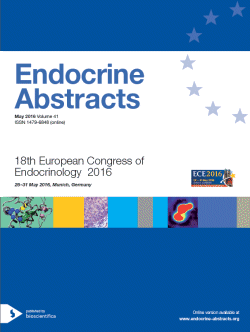Oral Communications
Reproduction & Endocrine Disruption
ea0041oc10.1 | Reproduction & Endocrine Disruption | ECE2016
Systemic enamel pathologies may be due to anti-androgenic effects of some endocrine disruptors
Jedeon Katia , Loiodice Sophia , Houari Sophia , Lenormand Manon , Berdal Ariane , Babajko Sylvie
ea0041oc10.2 | Reproduction & Endocrine Disruption | ECE2016
Human luteinizing hormone (hLH) and chorionic gonadotropin (hCG) display biased agonism at the LH/CG receptor
Riccetti Laura , Akli Ayoub Mohammed , Klett Daniele , Yvinec Romain , Gallay Nathalie , Combarnous Yves , Casarini Livio , Simoni Manuela , Reiter Eric
ea0041oc10.3 | Reproduction & Endocrine Disruption | ECE2016
LHCGR signaling promotes gonadal-like cell differentiation and proliferation in gonadectomy-induced adrenocortical tumorigenesis in mice
Chrusciel Marcin , Doroszko Milena , Jakobi Meike , Brouze Michal , Ponikwicka-Tyszko Donata , Bernaczyk Piotr , Anisimowicz Slawomir , Wolczynski Slawomir , Toppari Jorma , Huhtaniemi Ilpo , Rahman Nafis
ea0041oc10.4 | Reproduction & Endocrine Disruption | ECE2016
Impaired adipose function in PCOS – evidence that the primary abnormalities are in subcutaneous rather than visceral fat
Siemienowicz Katarzyna , Coukan Flavien , Lerner Avigdor , Franks Stephen , Rae Mick , Duncan Colin
ea0041oc10.5 | Reproduction & Endocrine Disruption | ECE2016
Effect of clomiphene citrate and metformin on testosterone levels in hypogonadal obese men with impaired glucose tolerance (IGT) or type 2 diabetes (DM2)
Pelusi Carla , Giagulli Vito , Baccini Margherita , Fanelli Flaminia , Mezzullo Marco , Fazzini Alessia , Casadio Elena , Prontera Olga , Pagotto Uberto , Pasquali Renato




